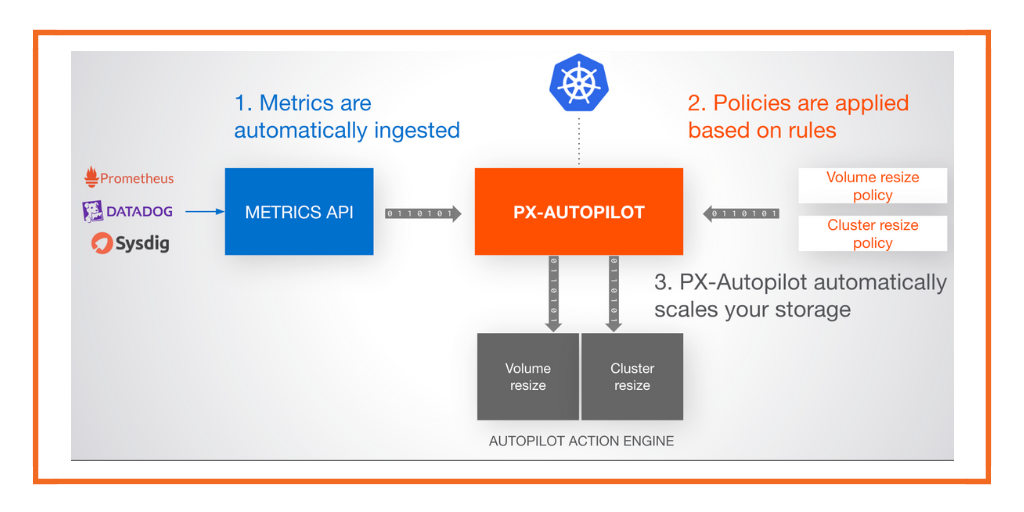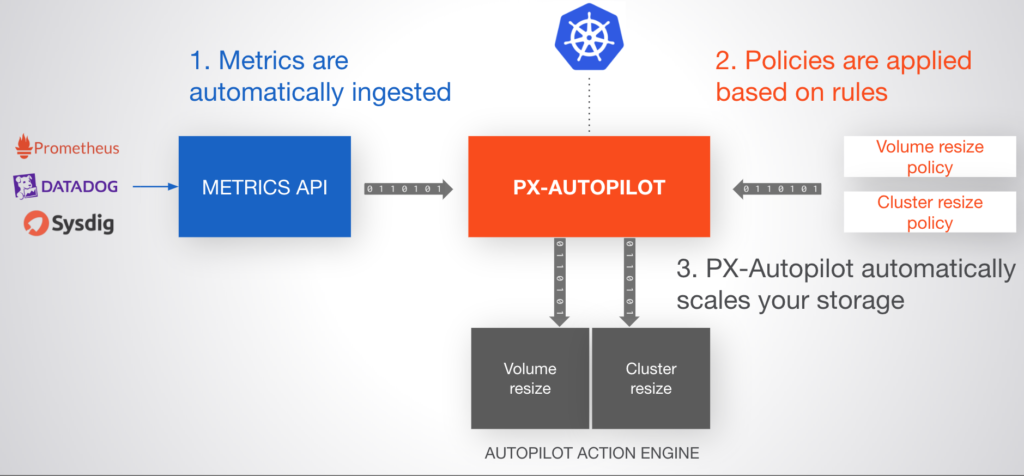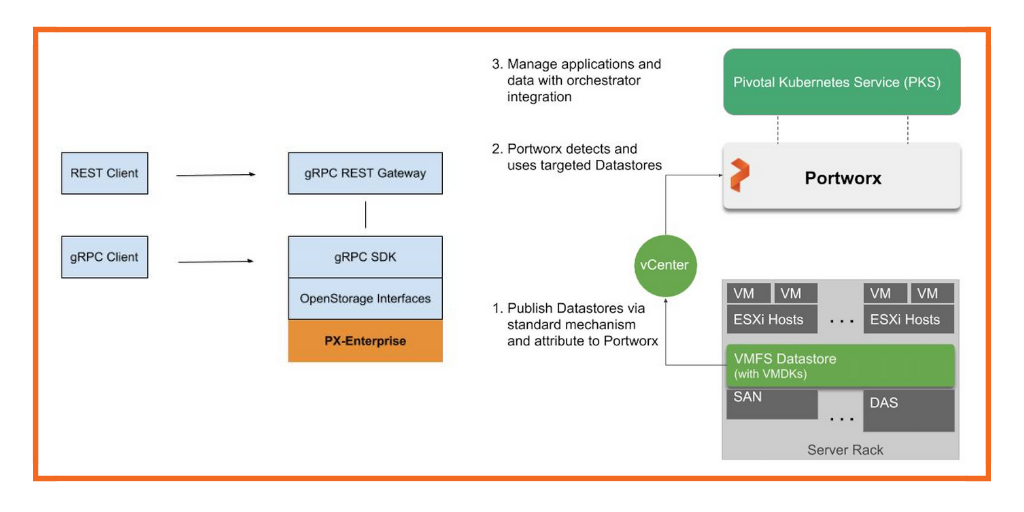Portworx Guided Hands On-Labs. Register Now

A majority of Portworx customers are building an as-a-service model using Kubernetes for container orchestration and Portworx for storage orchestration. While these customers have already gained remarkable agility for their end-users with automation, they still face some challenges when it comes to making these platforms truly self-service from an infrastructure scaling perspective. After all, while Kubernetes and Portworx can automate deployments and Day 2 options for applications, the infrastructure on which these applications run must still be provisioned and scaled itself. Additionally, DevOps and shared services IT teams are being tasked with producing financial models with cost/benefit analysis, and implementing chargeback methodologies to enhance cost savings and enable predictable spending. With the shift to public cloud infrastructure, cost management is an increasingly significant concern, as many customers end up paying more per unit in the cloud than they formally did on-prem. The latest product offering from Portworx, PX-Autopilot for Capacity Management tackles these problems head-on by providing automated operations for storage infrastructure while slashing cloud storage costs in half.
PX-Autopilot for Capacity Management
PX-Autopilot for Capacity Management, which is available today, enables you to automate scaling of storage services both for specific applications (e.g. PVC resizing) as well as at the infrastructure level (e.g. storage pool resizing). Both of these capabilities are now Generally Available with Portworx Enterprise 2.3.1. This is a significant milestone as we drive towards our vision of empowering our customers to build comprehensive enterprise-grade self-service Kubernetes application and data platforms across all on-premises and public and private clouds.
When we began working on this, our goals were very simple:
- Reduce unnecessary steps to dynamically scale storage capacity for applications, and
- Manage IaaS storage with no downtime.
With the PVC resize feature in PX-Autopilot, users can expand PVCs automatically before they begin to run out of space. PX-Autopilot also leverages your existing monitoring solution (e.g. Prometheus) to monitor the metrics in the cluster and detect high usage conditions. When these conditions are met, Autopilot directs Kubernetes to resize the PVC according to customizable rules. These rules are very simple to understand and extremely flexible to implement. They can be applied with specific labels on one or all namespaces in your Kubernetes cluster. As these clusters scale, there will be a time when growing PVCs is simply not possible due to infrastructure limitations and this is where Autopilot leverages the flexibility of the public cloud to auto-resize storage pools by adding additional cloud drives on demand. Here, the user has to just provide a minSize, and an optional maxSize, in the StorageCluster spec and the Autopilot rules automatically scale your storage pools as usage grows. Pool resizing is currently available for Microsoft Azure and vSphere volumes, with support for Amazon EBS and Google Persistent Disk coming soon.

Resize storage pools with PX-Autopilot
Cloud Cost Savings with PX-Autopilot
In addition to savings of up to 20 hours of manual work scaling a storage cluster, the ability to automatically expand storage on-demand in the cloud delivers significant cost savings for our customers. While Kubernetes automates the deployment of applications, enterprises must also be able to automate their underlying infrastructure to ensure they have sufficient compute and storage available to scale applications. In the cloud, even though enterprises were promised a pay-for-use model, the reality is that they must manually manage the challenge of scaling storage capacity for data services running on Kubernetes by overprovisioning block storage, often by 2-3x. This means they pay for storage even though it goes unused. PX-Autopilot for Capacity Management enables enterprises to cut their storage bill in half by automatically detecting when storage capacity is running low and provisioning more only when it’s needed.
One of our customers has already seen how they can scale beyond the limits of public cloud storage in the case study here. With Portworx Enterprise as a thinly provisioned storage layer, users never had to overprovision their cloud storage. Now with the new capabilities introduced in Autopilot, users can let the platform scale by itself and respond to the ever-growing needs of their business in real-time.
Let’s look at an example. Say you are running a cloud native applications in a public cloud like AWS. Your application needs are such that you want 10,000 IOPS using performant SSD drives with gp2-volumes. You have 10 such applications and need 1TB max capacity for each volume.
Without Portworx Enterprise, you will have to provision ten (10) 3.33 TB EBS volumes to get the required IOPS (EBS provides 3 IOPS per GB of storage, so providing 10,000 max IOPS per volume requires a 3.33 TB volume, even though only 1 TB max capacity is required). With Portworx, you can start with a single minimally sized EBS volume (10TB) which Portworx virtualizes into ten (10) 1 TB volumes to serve the individual applications. PX-Autopilot for Capacity Management would then expand the volumes later as demands changeBased on our calculations you will save at least 54% of your storage costs over a year.
This is before you take into consideration further benefits of reduced compute needs because you hit cloud provider maximum disk volume attach limits, or any additional software licensing you may require for your Kubernetes deployment.

Additionally, you can get additional savings by using Portworx to tier volumes to lower-cost classes of cloud storage, or archive via snapshots to S3 compatible storage. In the above example, if you were to use st1-hdd as the secondary tier for Portworx to schedule a class of applications and leverage it for 50% of storage needs, it would result in 64% savings. Similarly, instead of paying the cloud provider for storage snapshots, there are additional gains to be had by using local snapshots or snapshot to S3 using Portworx. If you decide to snapshot 1/3rd of the data to S3 with Portworx instead of using EBS snapshots, it will result in 62% savings.
We will soon be adding the capability to automate these workflows using PX-Autopilot. The results are summarized in the table below but if you are interested in learning more about the cloud cost-savings models, please reach out on our website and we’ll be in touch with you shortly.

Here is what our partner Pivotal had to say about PX-Autopilot.
“As we see more customers moving mission-critical applications to Pivotal Container Service (PKS), it is essential that our ecosystem continues to evolve to meet customer needs. We are excited that Portworx continues to expand its offering with PX-Autopilot, enabling PKS customers to scale their storage capacity dynamically and with no downtime.”
– Angus MacDonald, General Manager, Global Alliances at Pivotal.

This is just the beginning of PX-Autopilot and its mission to make cloud native storage truly automated and affordable for multi-tenant as-a-service platforms with SLA guarantees. If you want to learn more with specific application examples and try out this exciting new feature by yourself, please sign up for demos, videos and hands-on tutorials here or log into your PX-Central account.
Share
Subscribe for Updates
About Us
Portworx is the leader in cloud native storage for containers.
Thanks for subscribing!





